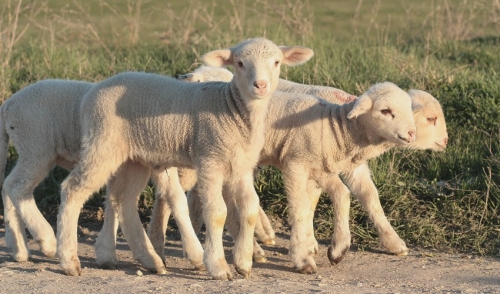{article.name}
Stay Informed
Starting Young Nursing Lambs on Feed

- Share this:
- Share on Facebook
- Pin on Pinterest
- Tweet on Twitter
Transitioning very young lambs over to feed is critical to growth rate and show ring success. Here’s a method that has been used successfully by many breeders.
The first step is to identify your goals for lamb feeding:
February or March lambs that will show in August need to grow as quickly as possible, while February or March lambs showing in winter (January through February) will not require explosive early growth.
Sound Management
It’s a good idea to leave a ewe with her lambs in a lambing jug for at least three to five days or longer, post lambing. When the lambing jugs (or pens) become full, make room by removing the ewe with the oldest lambs first.
Ewes with more than one lamb will have much greater nutrient requirements than single-birth ewes. If you have room to group them, it pays to feed ewes according to the number of lambs they are nursing.
Also, it’s imperative to deworm ewes within 24 hours after lambing to prevent worm infestation in the newborn lambs.
Good Nutrition
One of the most important aspects of starting lambs on feed is providing a place where lambs can gain access to the feed, but the ewes cannot. A “creep feeder” can be sophisticated and complex, or a simple wooden design. Whatever form it takes, its purpose is to keep the ewes away from the creep feed.
If space permits, make the creep feeder large enough to accommodate all of the lambs at once. Think ahead. Visualize the lambs at 60 to 70 pounds, then provide sufficient room to accommodate at least 75 percent of the lambs at any given time. Lambs grow quickly, and when you limit the size of the creep feeder you are essentially restricting their access to feed and possibly limiting growth.
Some lambs will begin nibbling on feed at seven to 10 days. Young lambs usually like alfalfa hay, so use it to entice the lambs into the creep feeder.
Another excellent method is to offer soybean meal alone in the feeder for five to seven days. Young lambs are very receptive to the flavor of soybean meal and will usually consume it eagerly. About one week after lambs begin eating, place either HONOR® Showlamb Starter DX Pellets or Show Chow® Lamb Starter Pellets DQ on top of the soybean meal. Over a two-week period, gradually decrease the ratio of soybean meal and increase the pellets. Continuing to offer soybean meal for two weeks encourages the smaller, younger lambs to enter the creep feeder and begin consuming feed.
Because lambs are typically born January through April, the weather can be cold and harsh. Offering a clean, warm, well-lighted (day and night) creep feed area not only keeps lambs healthy but encourages them to eat as well. Once they start consuming feed, keep the feeder full and let them go at it. It’s also a good idea to routinely offer high quality alfalfa hay in the creep area.
Good Healthy
There are a couple of health concerns that must be addressed. Enterotoxemia, or “overeating disease” is caused by Clostridium perfringens Types C & D. These are bacteria that normally live in the small intestine of sheep. When lambs begin consuming feedstuffs that are high in crude protein, these bacteria can proliferate quickly.
The waste products of these bacteria are toxic to the lamb and affect the central nervous system, causing rapid death. Contrary to what you might expect, the largest, healthiest looking lambs are typically the ones affected first. This is because they are spending a lot of time in the creep feeder. The rapid death of apparently healthy lambs due to this disease has given rise to the legend that “a lamb is born looking for a place to die.”
Treatment for enterotoxemia is usually fruitless, which makes prevention a virtual necessity. Ideally, you should vaccinate lambs for overeating before they begin consuming feed. Some lambs, however, begin eating at seven days old. Since these lambs are likely too young for the vaccination to be effective, and since they are rarely consuming enough feed to cause bacterial proliferation, you may elect to vaccinate at about two weeks of age and again at four weeks.
It’s a very good idea to vaccinate for tetanus at the same time, and several companies make a dual vaccine for both Clostridium perfrigens Type C&D and Clostridium tetani (CD/T vaccine). Remember to use a toxoid vaccine as opposed to an antitoxin. (Basically, a toxoid vaccine requires about two to four weeks to produce full immunity, while an antitoxin begins working almost immediately but lasts only about two weeks.)
Here’s a good rule of thumb. If lambs have started on feed, and your region has a history of overeating, give the antitoxin initially, followed by the toxoid vaccination in two to three days. Repeat the toxoid vaccination in two weeks. You may also wish to deworm lambs at about six weeks of age, even while still nursing.
Special Offers


Comments